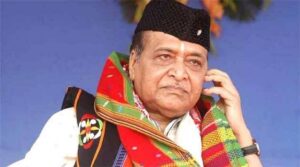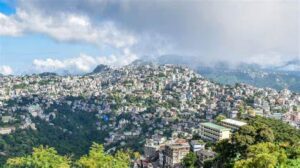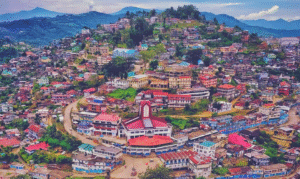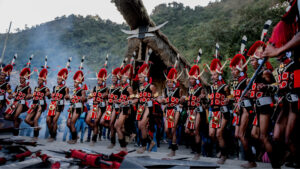Deep within the hills of Meghalaya, India, resides the Pnars. They are a vibrant sub-tribe of the larger Khasi people. They describe themselves as the “Ki Khun Hynűiew Trep,” meaning “Children of the Seven Huts.” They proudly claim the West and East Jaintia Hills
districts as their own land. Their unique language, Pnar, echoes closely with the dialect of their Austro-Asiatic lineage.
Matrilineal traditions bind their society, ensuring ancestral wisdom and property flows through generations of Pnar daughters. Ancient customs and the deep respect for nature thrives amidst the beauty of Meghalaya’s hills and valleys through this tribe.
History
Like all other Khasi tribal sub-tribes, the Pnar people claim to be derived from Ki Hynϱiew Trep. The Synteng group included the kings of the mediaeval Jaintia Kingdom. The Kingdom was taken over by the British East India Company in 1835, and it later became a part of the province of Assam. The district of Jaintia Hills was founded in the area following the founding of the Meghalaya state in independent India in 1972.
Spirituality
The Pnar tribe’s ancient religion is called Niamtre. According to the tribal beliefs, Niamtre was sent by God and was not created by humans. It was brought into this world by divine decree. The three cardinal principles that God has prescribed are Tipbru tipblai, Tipkur tipkha, and Kamai yei hok. They represent moral behaviour based on earning a living, fulfilling one’s obligations to others, and respecting the people in one’s mother’s and father’s clans to approach God.
Religion
In Jaintia Hills, Christianity (60%) dominates, with Catholics and Protestants leading the way. However, 40% hold onto their ancestral faith, Ka Niamtre, emphasizing right living and honoring ancestors.
Pnar Cuisine of Meghalaya
Pnar’s love bold flavours and proper nourishment. Their dishes are infused with the spirit of the land and honed over generations. For the Pnars, meat such as pork, tender goat, or even adventurous options like duck and squirrel takes centre stage in their daily meals. It is cooked with locally grown vegetables and aromatic spices.
Don Sain is the signature Pnar dish featuring juicy pork strips cooked in a rich sesame sauce. Ja Doit is rice porridge boiled with local herbs and spices. This bites the chilly winter hills. Doh Khleh is another such spicy delicacy.
They relish locally harvested vegetables like pumpkins, beans, and leafy greens, often incorporating them into stews, curries, and side dishes. Freshly caught fish from the rivers also find their way onto Pnar tables, cooked with simple herbs and spices to retain their natural sweetness.
No Pnar feast is complete without their beloved Ka Sohliah, a homemade rice beer. Fermented with rice and indigenous herbs, Ka Sohliah offers a refreshingly tangy and slightly effervescent brew, enjoyed during celebrations and everyday meals alike.
The Pnars add locally found honey into desserts like Ka Ryndia, a steamed rice pudding, and Ja Dohbleih(a fermented rice and banana delicacy).
Traditional Clothes
The Pnar women wear the traditional Jingsem, which is an intricately hand-woven cloth bejewelled
with colourful horizontal stripes and geometric patterns. It symbolises their social status and lineage. The wider the stripes, the higher the wearer’s standing within the community. It is worn with a blue or black traditional blouse called Dohkha.
Men, on the other hand, wear the Ri-Shyngῆong. It is a knee-length dhoti-like garment woven from cotton or silk. Often striped or checkered, the Ri-Shyngῆong is paired with a black or blue jacket called a Jymphong for a complete outfit.
Both men and women adorn themselves with exquisite jewellery crafted from silver, beads, and feathers. Necklaces, earrings, and bracelets, often featuring intricate geometric patterns, add a touch of sparkle and cultural significance to their attire.
Musical Instruments
Ramynthei is a single-stringed bamboo fiddle which is the heart and soul of Pnar music. It has melancholic tunes narrating tales of joy, sorrow, and the Pnar’s deep connection to their land.
Duitara resembles a two-stringed lute whose strums accompany the Ramynthei.
Ksing/Nakra is a bamboo nose flute that adds a touch of sweetness to Pnar music to evoke the tranquillity of the hills.
Ramynken, Shawiang, and Tangmuri are percussion instruments, including drums and cymbals, to offer the energetic pulse of Pnar music. Their lively rhythms bring communities together during festivals and celebrations, pulsating with the spirit of the Pnar people.
Festivals
Pnar festivals in Meghalaya burst with lively life. They celebrate the land’s abundance, the rivers, and the hills’ grip.
Behdeinkhlam chases away evil spirits at harvest time, while Chad Sukra purifies with cleansing fire. Chad Pastieh is celebrated to showcase gratitude for a good year, and Laho Dance tells the Pnar story. These joyous celebrations preserve the Pnar’s community spirit.
Occupation
The Pnar tribe of Meghalaya, India, traditionally follows a variety of occupations, primarily centred around agriculture and animal husbandry.
Agriculture: The Pnars are skilled farmers, cultivating rice, maize, millet, and other crops on the fertile slopes of the Jaintia Hills. They practise traditional techniques like terrace farming and jhum cultivation (shifting cultivation) to adapt to the hilly terrain.
Animal Husbandry: Raising livestock like pigs, goats, and poultry plays a crucial role in the Pnar economy. They utilise animal products for food, income, and religious ceremonies.
Weaving: Pnar women are renowned for their weaving skills, crafting exquisite textiles like the Jingsem (women’s dress) and Ri-Shyngῆong (men’s dhoti) using indigenous techniques and vibrant colours.
Handicrafts: Carving wood and bamboo into utensils, furniture, and musical instruments is another traditional occupation among the Pnars. Their intricate craftsmanship reflects their connection to nature and artistic skills.
Conclusion
Pnars’ adaptability, resourcefulness, and deep connection to the land have allowed them to thrive in the unique environment of Meghalaya. Due to social and economic changes, many Pnars today also work in various sectors like government jobs, education, and healthcare. Even if for economic reasons, they have chosen to enter the mainstream land, yet their traditions continue to hold cultural significance and shape their way of life.
Unravelling a billion untold stories, one chapter at a time, Humans of Northeast takes you on a discovery through vibrant Northeast India – a land rich in people, places, and culture. Ready to immerse yourself in more such stories?
Visit our page HONEI to read more about narratives that inspire and uplift.






